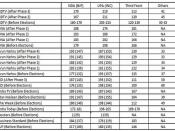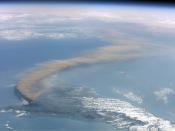PREDICTING VOLCANOES
John Doe
4/7/03
Per.6
With more and more of the world's population coming to live under the shadows of active volcanoes, an accurate prediction of when and where a volcano will erupt is critical. This report will focus on the main ways to predict when a volcano will erupt, how a town can be saved from an advancing lava flow, and the ways a volcano can be helpful in the long run.
All volcanoes that are believed to be a threat can be monitored... for a price. The equipment and personnel needed to monitor a dangerous volcano comes at a very steep cost. Ironically most of the world's very active volcanoes are in third world countries that cannot afford to monitor the volcanoes inside their country.
There are three main ways of monitoring a volcanic activity: tilt meters, surveillance by satellite, and seismographic monitoring. More frequent gas emissions and various squeaks, groans, belches, and wheezing noises can also warn of a coming eruption.
Hazard maps can also help the people in the most danger evacuate in time if their property is threatened by an eruption by showing where the lava will flow and so on.
Tilt meters are levels that are extremely accurate. Tilt meters are just pots that contain water or mercury. They are arranged in a triangle shaped way so that they can detect very minute ground deformations. The most noticeable ground deformation occurs when magma (molten lava) that is rising to the surface forces the ground to bulge to "accommodate" it. This can happen slowly or quickly over time, depending on how fast the magma is rising. Massive bulges occurred before the Mount Saint Helens eruption. Some of the bulges "grew" at a rate of five feet per day.
Satellites are becoming more technologically advanced...


